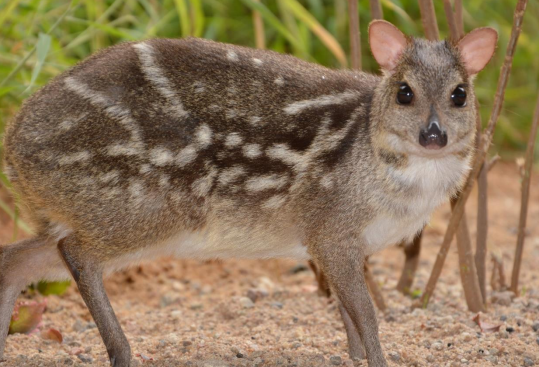CSIR - Centre for Cellular & Molecular Biology
Council of Scientific and Industrial Research
The Innovation Engine of India
Date : September 4, 2024

5 th December, Hyderabad: Mouse deer or Indian chevrotain plays a major role in the forest ecosystem as seed disperser and forms important prey for many small and large carnivores. Though it is commonly found in most of the forested areas, it has been listed in Schedule I and endangered in the Wildlife Protection Act (1972) due to frequent hunting for their bushmeat. A conservation breeding and species recovery program of mouse deer was initiated during 2010 by Nehru Zoological Park in collaboration with Laboratory for the Conservation of Endangered Species (LaCONES) at CSIR-CCMB with support from Central Zoo Authority. The program started with 06 individuals (02 males and 04 females), and aimed to increase their numbers in captivity and reintroduce them into the wild.
As part of the conservation breeding program, Dr G Umapathy’s group at LaCONESCCMB studied the reproductive behaviour of mouse deer in captivity. They discoveredthe occurrence of novel post-partum estrus (phase where the animal is ready to mate). They found that the female mouse deer shows estrus and mates within 4-6 hrs of delivery. This is the shortest post-partum estrus observed so far among large mammals. This finding led to a further study on understanding the reproductive physiology of the mouse deer using non-invasive methods. While analysing the hormone profiles, they discovered 16-androstenes sex pheromones (androstenone and androstanol) in mouse deer which have been previously reported to play a major role in the reproduction of pigs. The scientists examined molecular characteristics of these pheromones, their synthesis pathway and functions in the mouse deer reproduction.
“We found that pheromones levels were significantly elevated in the female mouse deers during delivery, post-partum estrus and mating. We also found a positive correlation between pheromones and estrogens one week prior to post-partum estrus and mating. These findings suggest these pheromones play a role in reproduction of mouse deer by bringing opposite sexes together for mating in the wild as they live in solitary life. Our findings have already helped in breeding of mouse deer at Nehru Zoological park but will also help other Indian zoos and elsewhere,” said Dr Umapathy.
These findings were recently published in the journal Cells, and the authors of the paper include Vinod Kumar, Manu Shivakumara, Caroline Karunakaran, Anupama Sekhar, Mamta Sajwan-Khatri, Sandeep Mushkam, Wasimuddin, Senthilkumaran Balasubramanian and Govindhaswamy Umapathy.
Reference: Kumar, V.; Manu, S.; Caroline, K.; Sekhar, A.; Mamta, S.-K.; Sandeep, M.; Wasimuddin; Senthilkumaran, B.; Umapathy, G. Discovery of 16-Androstenes (Androstenone and Androstenol), Their Synthesis Pathway, and Possible Role in Reproduction of Mouse Deer (Moschiola indica). Cells 2022, 11, 3837.
https://doi.org/10.3390/cells11233837
https://www.mdpi.com/2073-4409/11/23/3837
 Advertisement no 07/10 for the post Junior Scientist.
Advertisement no 07/10 for the post Junior Scientist.
 List of shortlisted candidates for the temporary positions against CCMB Web Notif.No.0724/B- [26-08-2024]
List of shortlisted candidates for the temporary positions against CCMB Web Notif.No.0724/B- [26-08-2024]
 Result of selected candidates for the temporary positions against CCMB Web Notif.No.0724/A - [21-08-2024]
Result of selected candidates for the temporary positions against CCMB Web Notif.No.0724/A - [21-08-2024]
 Notification of Schedule for Trade Test and Downloading of Admit Cards for the posts of Gr. II (1)/Technician (1) against Advt.No:01/2021 - [19-08-2024]
Notification of Schedule for Trade Test and Downloading of Admit Cards for the posts of Gr. II (1)/Technician (1) against Advt.No:01/2021 - [19-08-2024]
 List of selected candidates for the temporary positions against CCMB Web Notif.No.0624/A - [14-08-2024]
List of selected candidates for the temporary positions against CCMB Web Notif.No.0624/A - [14-08-2024]
 List of shortlisted candidates for the temporary positions against CCMB Web Notif.No.0724/A - [02-08-2024]
List of shortlisted candidates for the temporary positions against CCMB Web Notif.No.0724/A - [02-08-2024]
 Notification No.0824/A for various temporary positions on contractual basis- [02-08-2024]
Notification No.0824/A for various temporary positions on contractual basis- [02-08-2024]
 Notification No.0724/B for various temporary positions on contractual basis - [29-07-2024]
Notification No.0724/B for various temporary positions on contractual basis - [29-07-2024]
 List of shortlisted candidates for the temporary positions against CCMB Web Notif.No.0624/A- [19-07-2024]
List of shortlisted candidates for the temporary positions against CCMB Web Notif.No.0624/A- [19-07-2024]
 List of Provisionally empanelled candidates for Engagement as Project staff Vide Notif.No.2024/1 - [15-07-2024]
List of Provisionally empanelled candidates for Engagement as Project staff Vide Notif.No.2024/1 - [15-07-2024]